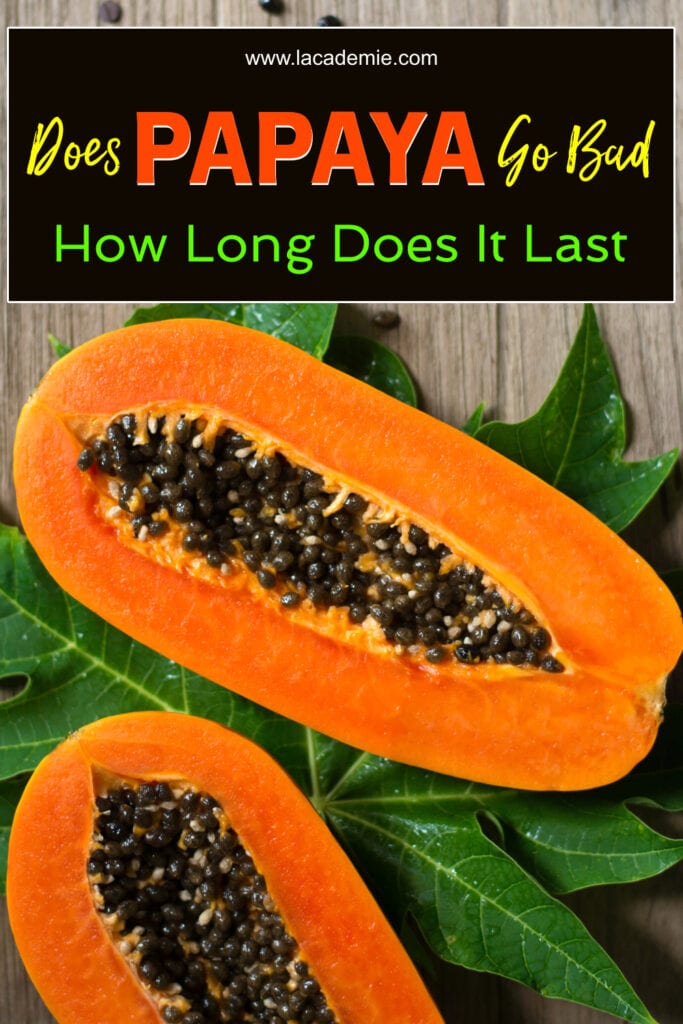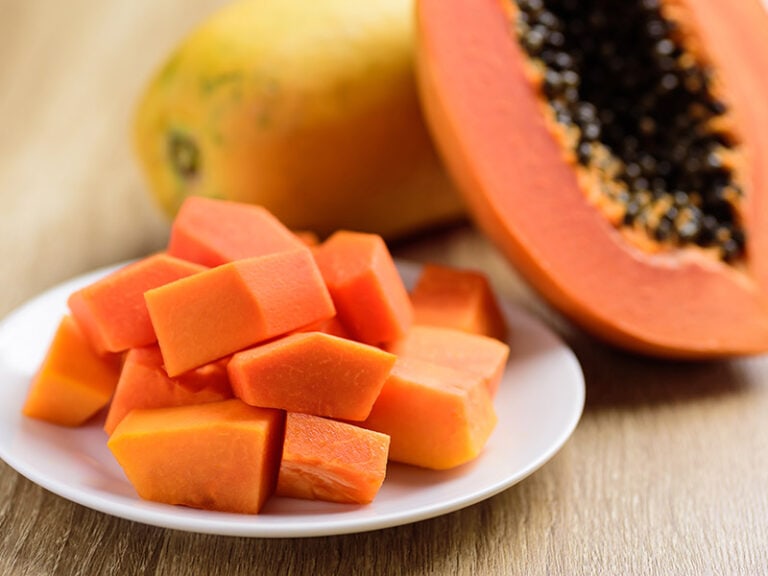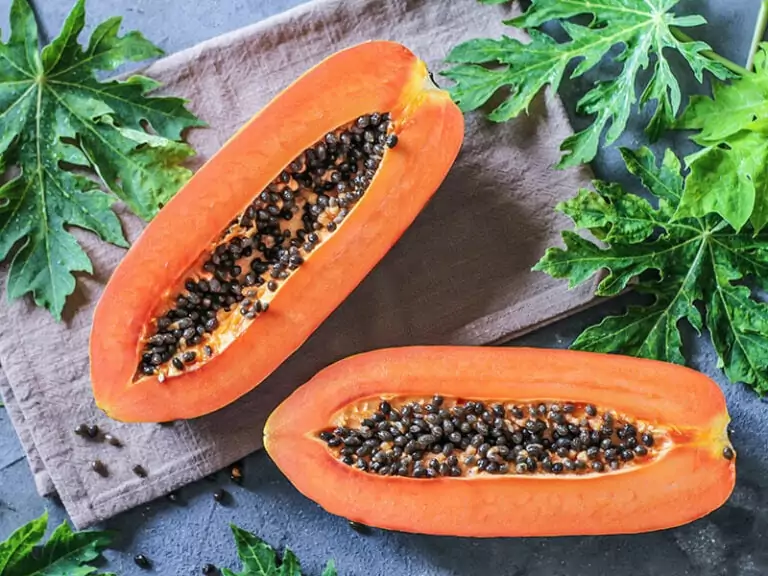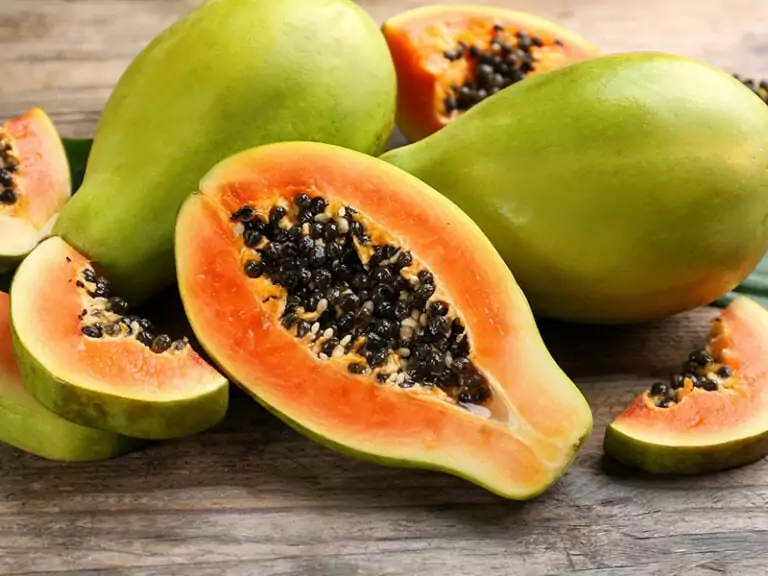Does papaya go bad? How long does it last? Or, put another way, what do you know about this fruit’s shelf life? This fruit, I must say, is an excellent source of nutrients and a fantastic experience in taste. What a pity to see how the wrong storage affects these gems.
Hello, papaya fans! I’m sure you would always want to see these tropical fruits available in your kitchen. During the journey, you will know how to keep the fruits fresh as long as possible, signs of spoilages, recipes, and more. That’s why my article should be on your reading list.
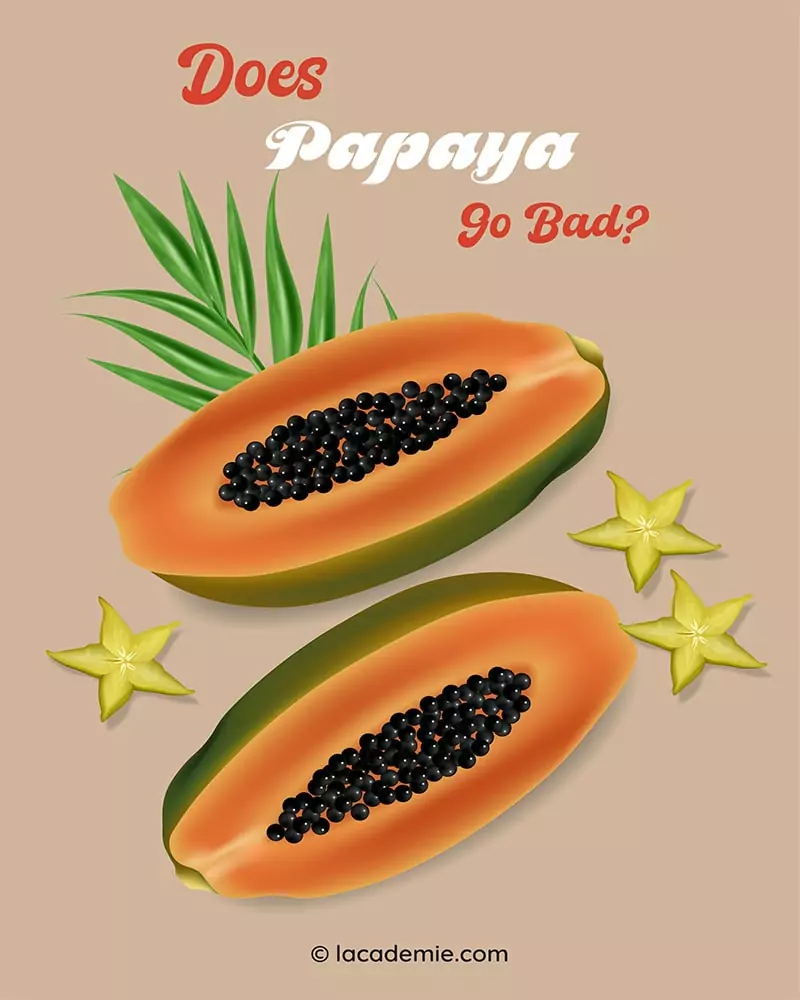
What Is Papaya?
Before taking things further, let’s warm up with some information about papaya, such as where it came from or how to choose the ripe fruits from markets.
Traces Back To The History
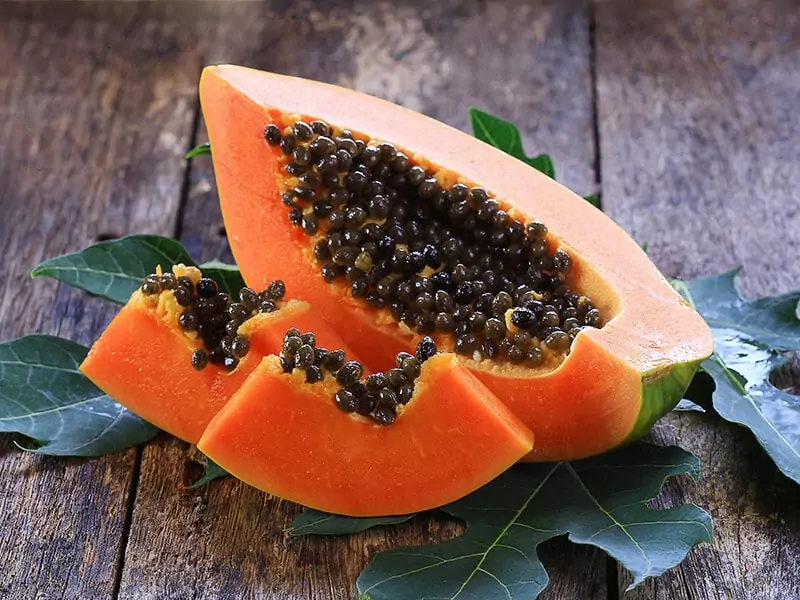
There is no exact date, but people believe this tropical fruit originated, and domestication happened in southern Mexico and Central America.
Papaya’s first appearance in the Dominican Republic and Panama was in the early 16th century. Not long after, this species debuted in Southeast Asia in 1550 as Spaniards brought the seeds to the Philippines. (1)
To date, the annual papaya production has passed 6 million tonnes globally. (2) India accounts for 43% of the worldwide papaya supply.
Guide To Pick Up Ripe Papayas
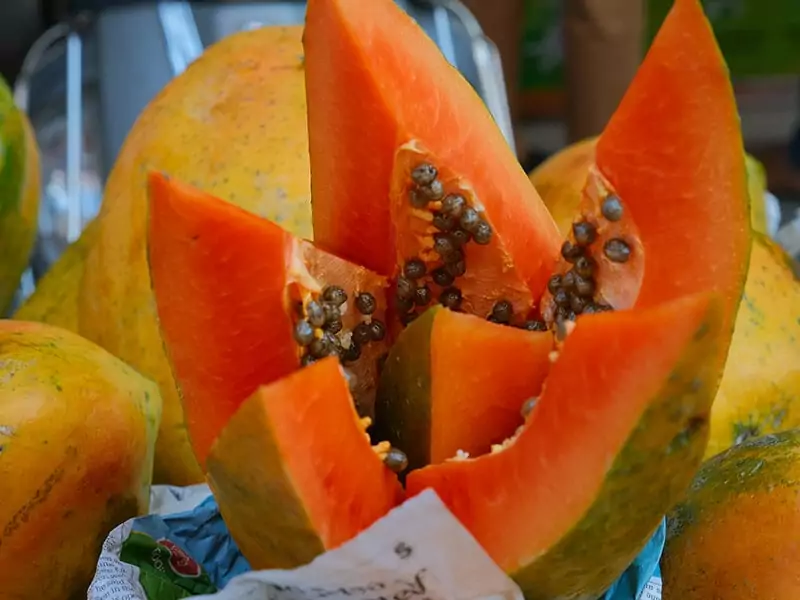
No matter where you buy papayas, at stores, or local markets, the selection of quality fruits is pivotal in ensuring the timing of their spoilage. Make sure to choose fruits at their best.
Color
One thing to note is that papayas (pawpaws) continue to ripen and improve their flavor even after leaving the tree. When mature, the exterior will change from green to yellow, and the rind shades are darker depending on the level of ripeness.
Therefore, it is necessary to buy fruits with yellow skins. Avoid choosing the orangish-yellow ones as they may be overripe.
Appearance
Scan the surface to look for mildew, mold, bruises, or tears. Once tears appear on the skin, fruits will spoil in a rush because the flesh has been exposed to air and bacteria.
Check for the stem end as well. The sign of papayas’ ripeness is the yellow ring. In contrast, the fruit is still young if the ring is green.
Weight And Smell
Set aside the visual evidence; use your senses to judge ripeness. Ripe fruits should be heavy and soft enough to yield with gentle pressure. The texture should not be firm enough and has a light sweet scent when you smell the base.
The unripe fruit doesn’t smell like anything, while there is a fermented and unpleasant odor emitted from the overripe one.
Some people can’t stand the odor of ripe papayas. If you are in such a case, here’s a trick to make you feel better. A few drops of lime could eliminate the unpleasant stinks and taste.
Now, you are able to choose the best pawpaws at markets with these tips.
Tastes Of Overripe Fruits
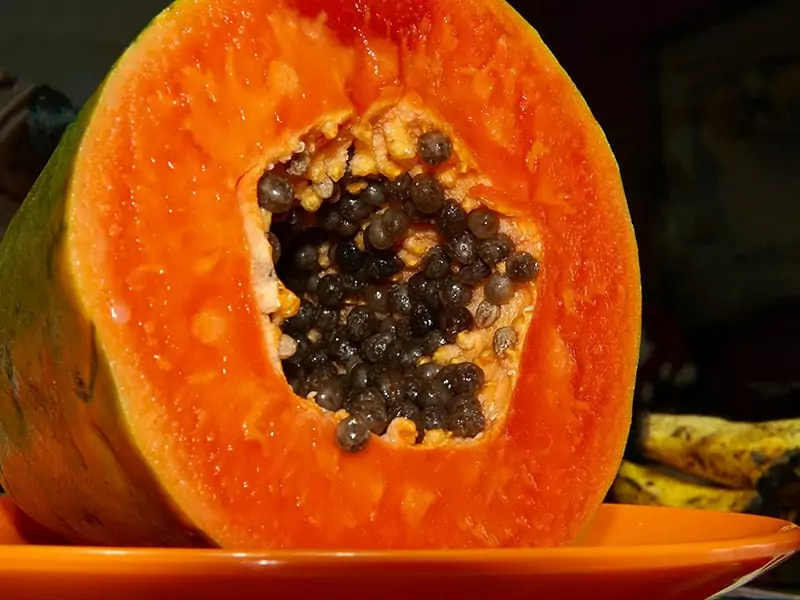
The flavor of papaw varies depending on its ripeness. Papaya taste will be at its peak at maturity with mild sweetness and buttery texture. On the contrary, the flavor of overripe fruit is not a pleasant experience for some people.
More specifically, overly mature papaws have an intense muskiness taste, and sometimes it becomes too much to handle. The meat is mushy and sickly sweet. No doubt, its rotten smell isn’t an ideal scent for your home.
Can Papayas Go Bad?
In a nutshell, yes. Unfortunately, like other fruits, though you have tried your best to preserve them, there comes the point of time when papayas show the sign of spoilage.
Are You Ready To Shed Some Lights On Papaya Shelf Life?
How long a fruit keeps fresh depends largely on storage conditions. Below is a frame of reference about the durability of papayas under particular conditions. Please note that all the figures are only rough estimates.
Unripe
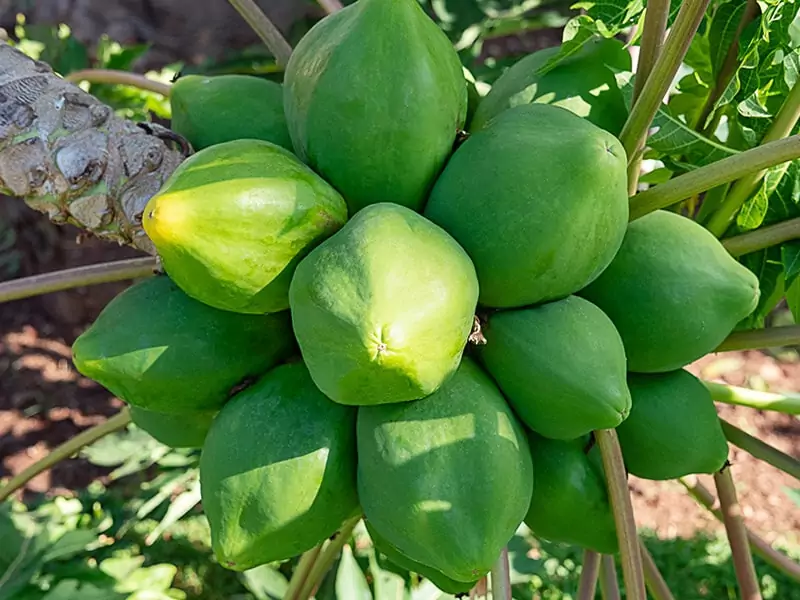
Apparently, young papayas take five days to one week to mature on the counter. But the high or low room temperature can shorten or extend the lifespan. Unlike the soft and partially yellow fruits, the green and fimer ones take more time to reach maturity.
Immature papayas will last about two weeks in the fridge. You should keep them in a different compartment from other fruits and vegetables. Particularly, being one place with ripe fruits like apples and bananas can affect the ripening process of raw papayas.
Ripe
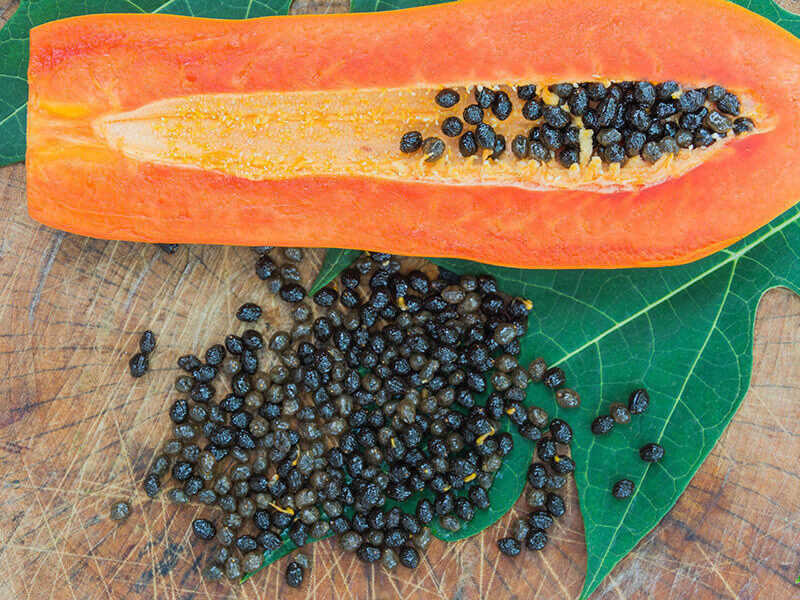
The average time ripe fruits can keep their freshness at room temperature is about 2 to 3 days. Needless to say, the life span can be extended or shortened, depending on the level of temperature.
If the degrees are lower than usual, mature papayas can last more than three days, not much, maybe a few more days.
Fully ripe papaya can maintain quality for about 5 to 7 days under cold storage. Remember that even if papaws sit still in the fridge, they will continue to ripen and improve the flavor.
Cuts
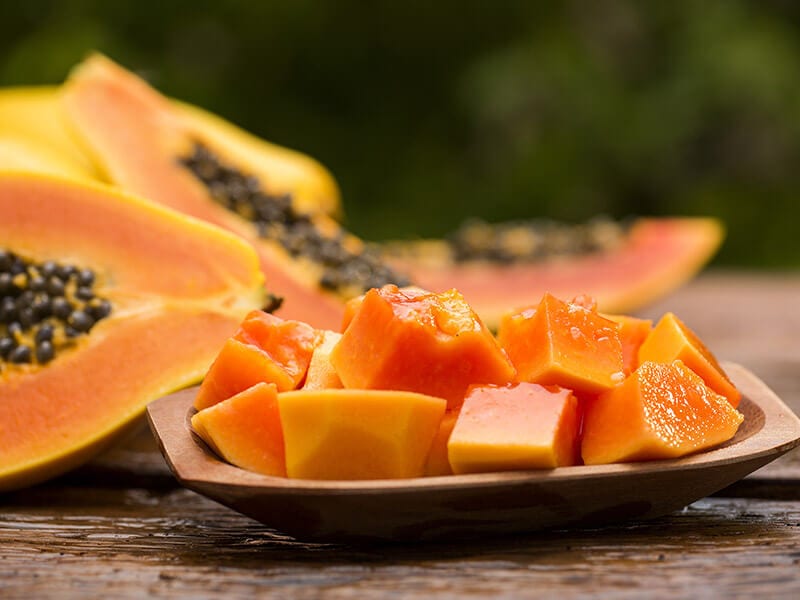
Learning how to correctly cut and eat a papaya is essential if you want to enjoy this fruit to the fullest. It is not common to leave chopped papayas unrefrigerated since they will degrade in quality within a few hours at room temperature. The cuts will become stale and sour if exposed to the air for a long time, especially in a hot and humid climate.
Usually, they don’t last for more than 3 hours in the pantry. Contrastingly, the chopped pieces shouldn’t go bad for about 2 to 3 days in the fridge.
Dried Papaya
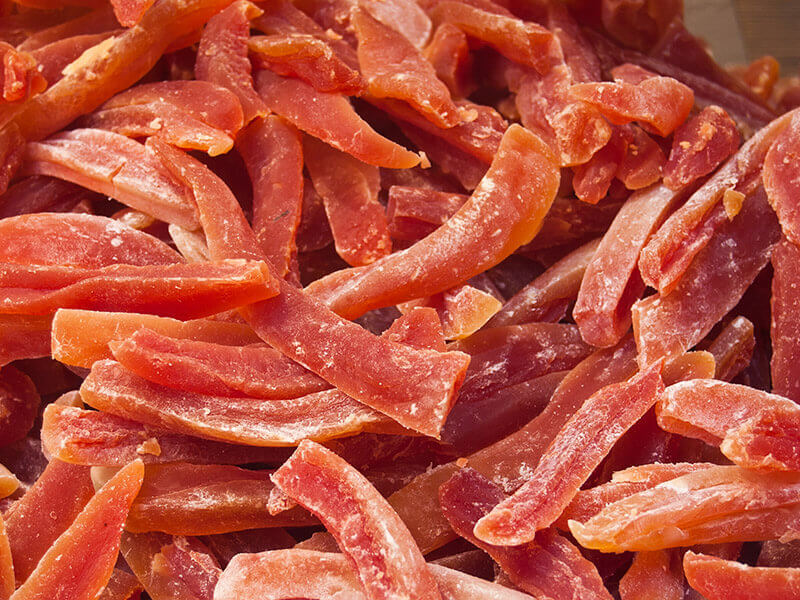
As you can see, there is dried papaya on the market. The expired date of the dried fried fruit is up to a year if it sits out at room temperature or in the cabinet. An unopened package can last longer than a year.
Refrigerating dried pawpaws can reach the same amount of time. Thus, there is no point in keeping the dried package in the fridge when they have the same shelf life as in the pantry.
Room temperature is ideal for storing dried papayas. Seal the package carefully to prevent flies and other pests.
If you haven’t known about dried papayas, here is your chance.
Signs Of Spoilage
The signs of rottenness are recognizable, so you are able to quickly identify which fruit has gone wrong. Here are several things to notice about rotten papayas.
Black and White Dots
It would be remiss if I did not mention the papaya fungus. In the rainy periods, the pawpaw tree often faces the problem of Asperisporium caricae, where black spots of fungus attack its leaves and fruits.
Infected fruits are easily recognized because of the surface’s numerous black spots. Scan the skin to see if any dark spot is available. A few black dots are fine, the flesh is consumable after cutting out the bad parts. But if they appear in density, something is wrong.
Another thing to check is the white spots, which could be the signs of fungus. But you can wipe them away with a clean cloth, so there is nothing to worry about.
Texture
Be cautious when you see any signs of soft spots or bruises on the surface. Sunken spots mean that extra moisture has invaded. The fruit is still edible with a couple of bad ones. It is best to toss them away if the whole fruit is soft and melting, as the bacteria would penetrate the meat.
Molds
The moisture in the air can support mold growing on the surface of cut papaya. It’s best not to eat fruits that have molds inside.
Unpleasant Odor
You know that ripe papayas always deliver a sweet and earthy aroma. Therefore, once these gems emit a fermented odor, it’s time to toss them away. Specifically, the bad papaya gives off a vinegary, pungent, lingering odor near the bottom.
Bitter Taste
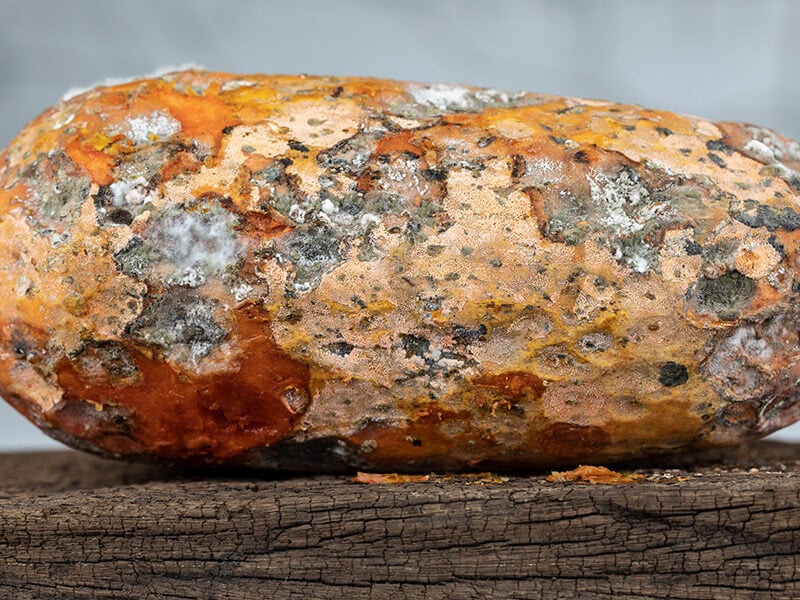
If you accidentally have a bite of spoiled fruit, you will know instantly because rotten papaws’ bitter taste is unpleasant to swallow. As a side note, young fruits or the bad ones will have no taste at all. If the taste is bland, you may eat it or throw it away.
All in all, there is no use lingering on the off-taste fruits. Discard them immediately if you sense something unfamiliar about the flavor.
Risks Of Consuming Spoiled Papayas
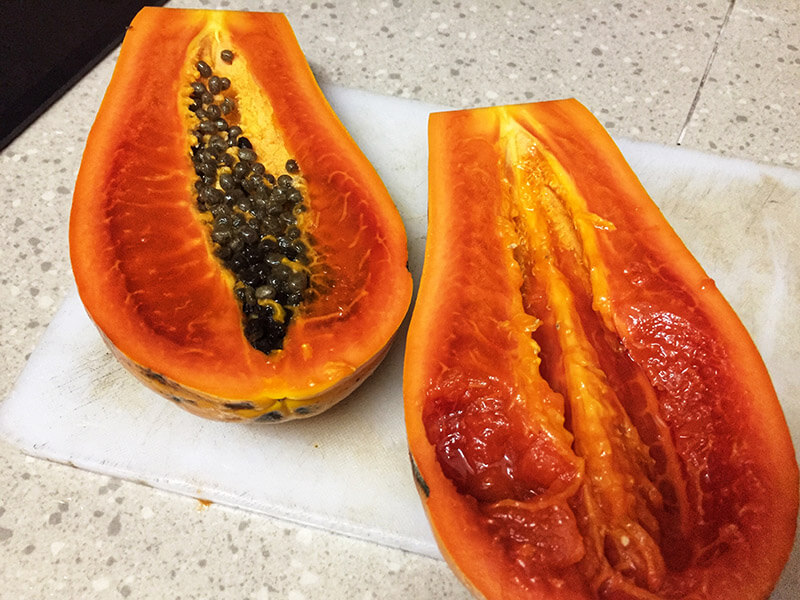
Chances that you eat the expired papaw are rare but not impossible. However, even if you did, try not to be overly anxious about it. Most people end up with no problems after consuming spoiled papayas.
Nevertheless, there is always an exception. A minority may experience more severe symptoms such as abdominal pain or skin rashes. If you are in such cases, seek medical help. Though expired fruits are harmless in most cases, it may be wise to avoid eating them at all costs.
Let’s Talk About Storage
My philosophy is you are what you eat. Fruits are like precious gems that need to be protected and well-cherished. Taking good care of these natural gifts is also protecting your health. Below is a guide to preserving papayas.
Storing Unripe Papayas
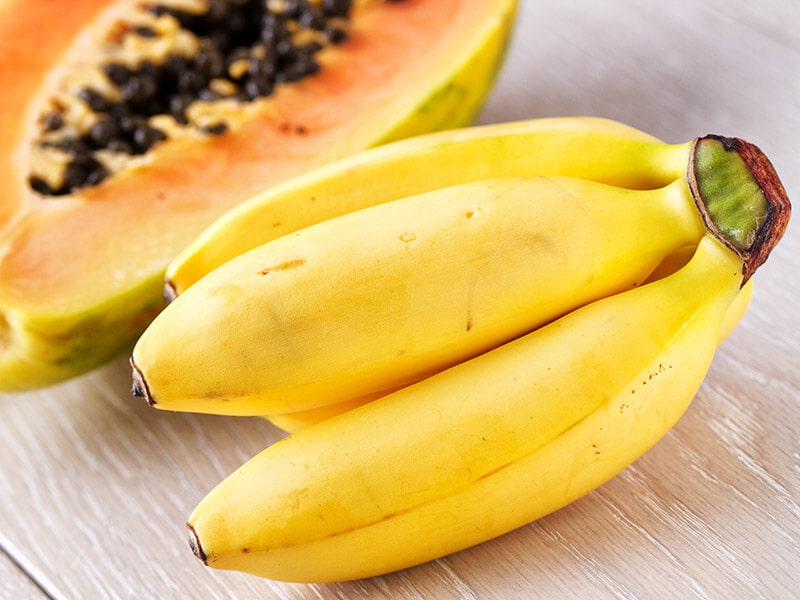
Like other fruits, you should keep papayas in a well-ventilated place and out of direct light or high heat sources if you tend to spread them in the pantry. The ideal temperatures are between 68 – 77°F.
One thing to note is that you should place them separately from other fruits that produce ethylene, such as apple, banana, avocado, and more. Otherwise, these fruits will accelerate the ripening process of papaws. As a result, the flavor will not be as sweet as it should be.
In contrast, if you want to speed things up and aren’t hung up too much about the flavor, put the fruit in one paper bag with a ripe banana, apple, or any ethylene producer. Whether in the fridge or at room temperature, papayas will be ripe within a day or so.
Frankly, refrigerators are not ideal places to store young fruits as the low degrees will slow down the ripening process. Thus, green papaw continues to ripen at a slow rate, and the flavor will become less sweet when eaten at a later date.
Guide To Preserve Ripe Papaws
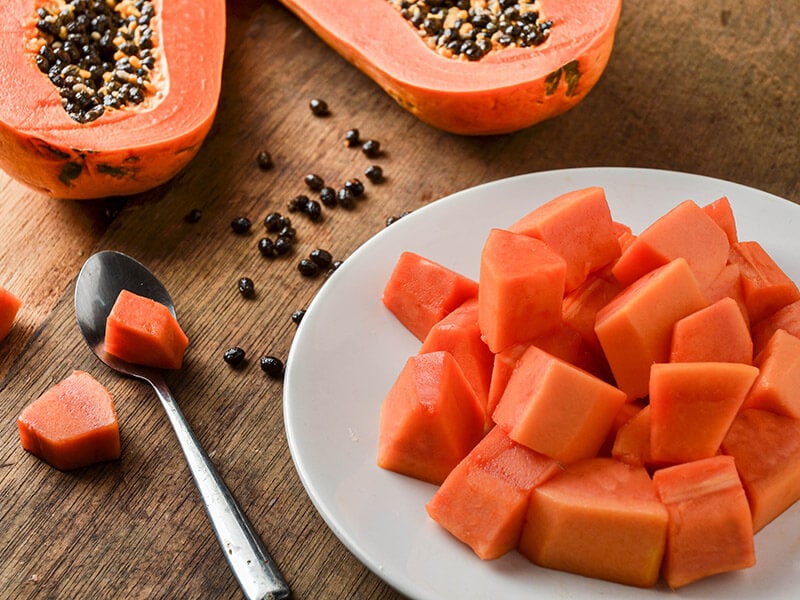
As I have stated earlier, once ripe, papayas only retain their flavor for a couple of days at room temperature. Consequently, you should only leave them unrefrigerated if you intend to use them for a short time. Remember to keep these gems away from sunlight and heat resources.
The ultimate temperature to store papaws is around 54 – 57°F. But I guess there are no storage spaces with that number of degrees available at your house.
Thus, the fridge is the best option to store these fruits at home. Regarding cold storage, cutting papayas into smaller pieces is optional since storing the whole fruit may take up a lot of space in the fridge.
As for chopped papayas, it is necessary to store them in airtight containers or sealable plastic bags to prevent oxidation. Oxygen can make sliced fruit turn brown. Remember this; oxygen is not a friend to ripe fruits.
Alternatively, cover the bowl of cut fruits with plastic wrap. By doing this, the cuts won’t get affected by other fruits and vegetables.
Learn how to preserve ripe pawpaws and save them for later use here.
What About Freezing?
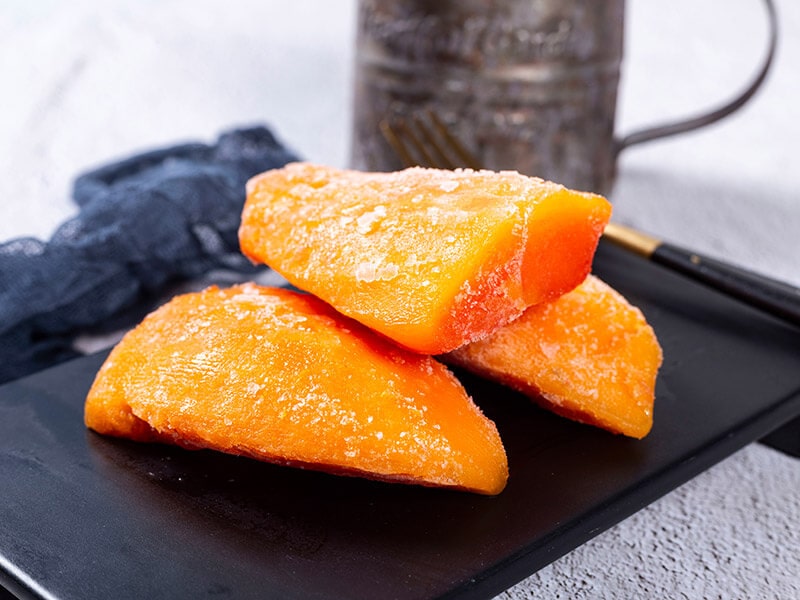
Of course, freezing is always the optimal choice to prolong the fruits’ shelf life. Frozen papayas can last about a year in the freezer. So, let’s see how to do it and what possible outcome it will bring.
How Can I Freeze Papayas
As the abovementioned, unripe fruits are not ideal for freezing. And you should only apply this method of storage to ripe papayas. In case you still plan to freeze papaya, you can follow these steps:
- Step 1: Cut or chop papaya meat into slices or cubes.
- Step 2: Pre-freeze the meat. Spread the pieces evenly on a cookie sheet or parchment paper, then cover them with another layer of paper. Then, put the fruits in the freezer for 2 hours or so. This step is to prevent your pawpaw chunks from sticking together.
- Step 3: Once the frozen papaws reach your desired firmness, transfer them into a freezer bag or airtight container and return them to the freezer. Containers keep the flesh out of cold air and prevent them from spoiling due to the freezer burn.
As for the puree, store it in an airtight container and seal it properly. The papaw puree can last for about a year or more if you don’t open the bag frequently.
The Downside Of Freezing Papayas
Unfortunately, during the freezing process, the taste and texture of papayas will change. It is possible that the defrosting will give the fruit a bitter and fermented taste. Not to mention that the meat will turn mushy and watery on the outside.
In such a case, that’s far from perfect for consuming it in fruit form, but making them into smoothies or milkshakes can be a solution. As a side note, bear in mind that you should never freeze raw papayas.
Immature fruits will stop ripening after thawing, and you will end up with tasteless and bitter mush. Nevertheless, if you still fancy the idea of freezing papayas, don’t forget to keep the cuts in the freezer bag or sealed containers. Go with what suits you the most.
Note Down These Tips For Better Preservation
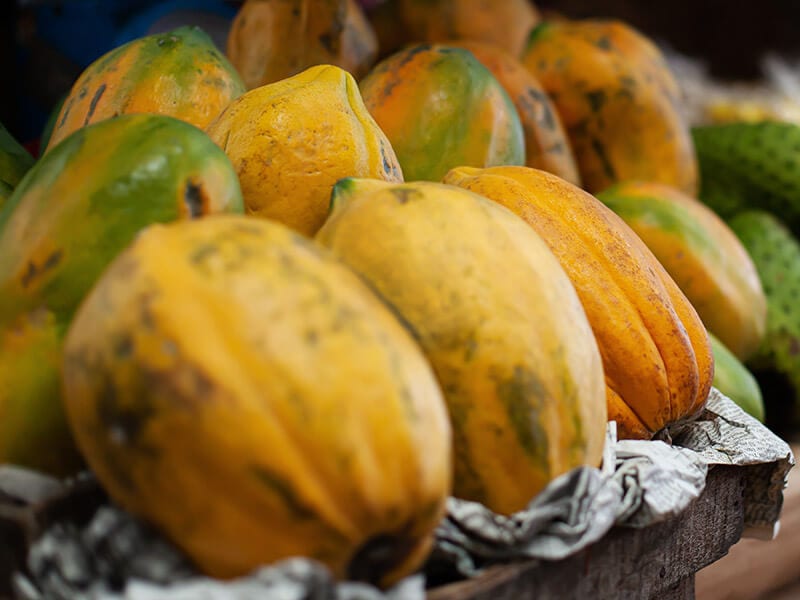
As you can see, I already had a thorough discussion about papaya storage above, but you can make a few more notes below to maximize the shelf life of the fruits.
- In case you can’t stand the odor of papayas. Here’s a trick to make you feel better. A few drops of lime could eliminate the unpleasant stinks and taste.
- Another way to accelerate the ripening process is by wrapping young papaya in a clean paper bag. Remember to check your fruits from time to time to make sure they won’t get overly mature.
- Because defrosted papayas can be mushy and wet, other options for a better taste are going for partially defrosted or thawed fruits.
- Though papayas don’t really need special handling, their meat is still quite delicate. Don’t put heavy vegetables or fruits over these precious gems.
- Avoid squeezing or hard pressure on the surface of the ripe fruits. Otherwise, this manner will leave bruises and ripped on the exterior.
- Little do you know, papaya seeds are worth saving. Once you take them out, rinse them and keep the tiny blacks for later use. The seeds are edible and can be used as a garnish or blended into a dressing.
Things You Can Do With Overripe Papayas
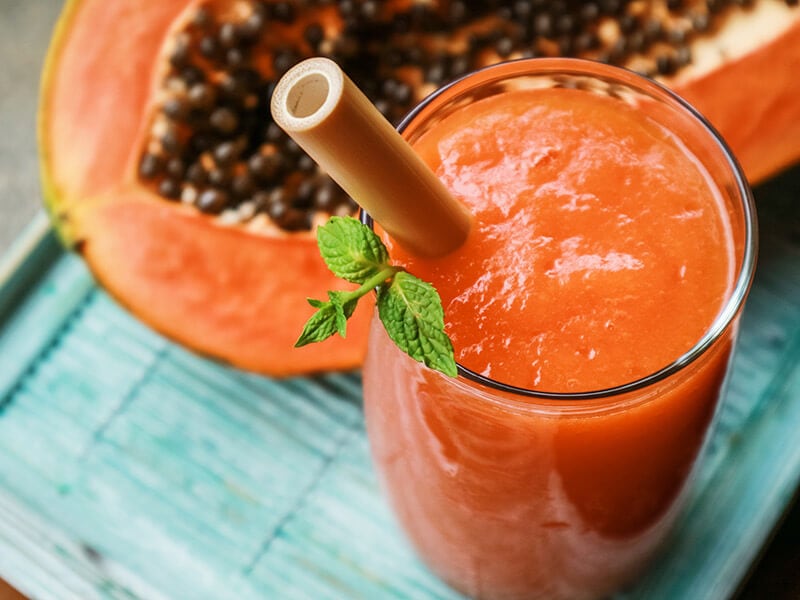
Sometimes, you may forget about the fruits in the fridge and let them be on the verge of rottenness. It’s a waste to throw them away, but you don’t know how to utilize these over mature papayas. If you are in such a case, some of my suggestions may remedy the situation.
Snack For Breakfast
One thing to remember is that papaya is good for your digestive system. Therefore, just consider overripe fruits as a breakfast snack to improve digestion and lose weight.
Making Salad
Alternatively, you can use the overripe papaya as a vegetable in salads and other companions such as cucumbers and tomatoes. People claim that the taste of overripe fruits is as sweet, sticky, and rich as ripe mangoes.
Besides, they can be a significant element of tropical fruit salad.
Turning To Drinks and Beverages
What can I say? The simplest and most effective treatment for overripe papaya is to make them into drinks. Play the mix and match game, and combine the sweet orange meat with other fruits for a delicious and healthy drink.
Take care of yourself with this super nutritious and tasty papaya smoothie.
Is Papaya A Healthy Fruit?
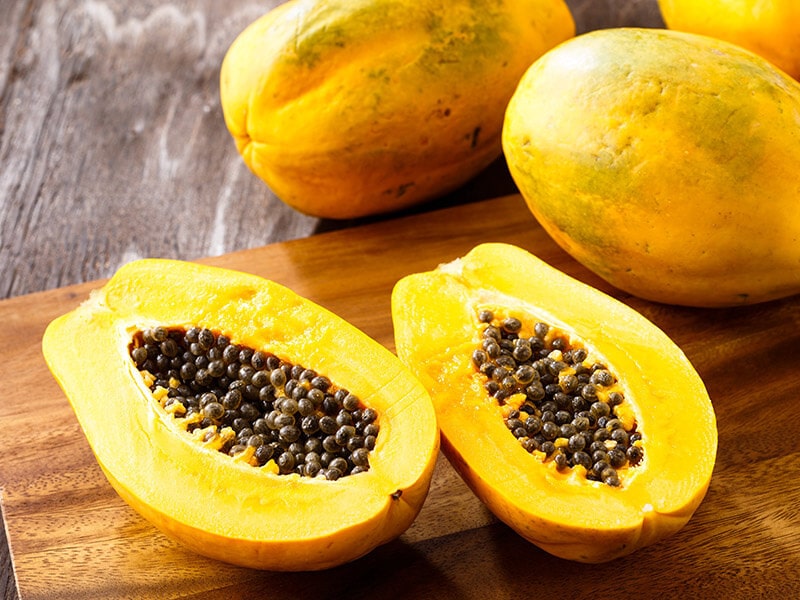
It is safe to assume that papayas are safe for most people. Raw consumption or processing of the fruit carries multiple health benefits.
Health Benefits
Pawpaw is a fruit with high nutritional properties. Below is the nutritional value of 100 grams of papayas:
- 43 Calories
- 1,7g fiber
- 182 mg of potassium
- 8mg of sodium
- 0,5g protein
- Vitamin A
- Vitamin C (3)
Let’s start with papain, an enzyme in papayas supporting digestion and treating infections. In addition, this fruit is a good source of fiber and water, which help promote regular excretion and maintain intestinal health.
Consuming papaws will help reduce the risk of cardiovascular disease thanks to the high fiber content, potassium, and vitamins. Moreover, the critical nutrient choline contributes to improving learning and memory.
Last but not least, this fruit is an excellent addition to your diet because it will help promote bone health, improve diabetes, and prevent cancer.
Gain more knowledge about papayas through its six health benefits.
Who Should Say Farewells to Papayas On Their Diets
Papayas are a friendly fruit to humans and perform many nutritional benefits. The gems are still a forbidden zone for people with some specific conditions and carry many side effects.
Pregnant women should avoid pawpaws during their pregnancy as the latex in the fruit may trigger uterine contractions, leading to early labor. Likewise, people with hypoglycemia, kidney stones, and diarrheal problems should also deduct this fruit from the grocery list.
Unfortunately, some people may suffer from papaya allergies. The symptoms include itching, lightheadedness, nausea, and diarrhea. If you experience such symptoms, go to the doctor immediately.
Easy Papaya Recipes That You Must Try Once
Pawpaws are indeed versatile “dancers” in many different dishes. They can be present on main dishes or desserts. These three recipes below are selections from the easiest papaya recipes. I’m sure you can succeed even if you are a newbie in the kitchen.
Papaya Salad Rolls
These salad rolls are a well-beloved dish by tourists and locals. Moreover, this dish is a perfect choice for spicy food lovers. To make the salad, you need to use raw or green papayas.
Young pawpaws are not as soft as when ripe. Their crunchy texture perfectly matches other ingredients such as carrots, beans, or tomatoes. And don’t forget to prepare yourself a handy julienne peeler tool to deal with papayas.
Papaya Mango Jam
Shame on me, but I admit that just hearing this jam’s name can make my mouth water. The combination of mango and papaya with freshly squeezed lime is an unforgettable experience.
In addition to fresh fruits, sugar is an indispensable ingredient in jam processing. It is worth noting that you will use two types of sugar in this recipe: white sugar and brown sugar.
Vegan Papaya Ice Cream
Ice cream is no ordinary snack but a sweet treat to boost your mood. Can you imagine how happy you are after enjoying an ice cream on a hot summer day? Calling all the ice cream lovers, this is what you are looking for.
Let me tell you a secret. The sauce includes cashews, coconut milk, and dates, which is oil-free and vegan. If you don’t have an ice cream maker – no worries! This recipe will explain it all. Plus, you only need to spend 30 minutes from start to finish.
How can you resist these colorful icy balls? Learn how to do it now!
FAQs
Sad to say, but I don’t have enough time to answer all the questions about papayas for you. Nonetheless, I hope this extra information will be of some help to you someday.
Be Gentle To Papayas!
Sure, now you probably know when papayas passed their heyday. Again and again, one thing to remember is that the pulp is quite soft and delicate. Thus, aside from choosing the proper preservation condition, you also need to be gentle in handling the fruit.
The combination of the above conditions ensures that the shelf life of papaya will be extended to the maximum. If you have any tips to keep the fresh fruit longer, please share them with other readers and me.
And if possible, you can send this article to other papaya fans. Thank you in advance.
Reference
- Dass, A., 2022. Papaya | Infopedia. [online] Eresources.nlb.gov.sg.
- Nhb.gov.in. 2022. PAPAYA.
- Nutritionix.com. 2022. {{MetaTags.title || ‘Nutritionix’}}.
